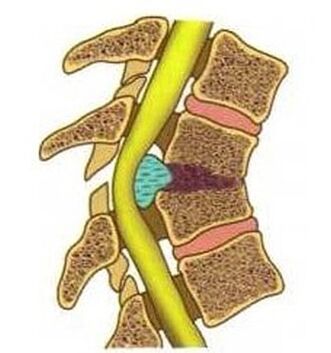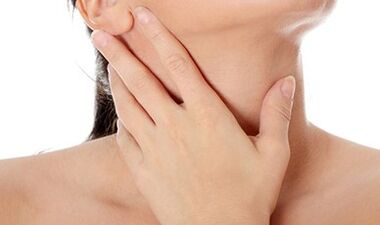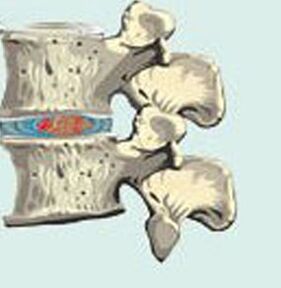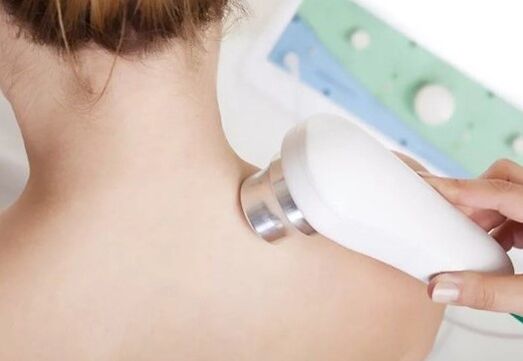Osteochondrosis is a degenerative-dystrophic spinal disease, in which the intervertebral disc wound is in their deformation, height reduction, and stratification is recorded. This pathological manifestation is varied, but they can be combined into several syndrome. Depending on the severity of the symptoms, the change in the intervertebral disc that surrounds their structure, several stages of osteochondrosis are distinguished. Before treating osteochondrosis of the cervical area, it is important to know why various methods of medicine, physiotherapy and surgery are required.

General information
Cervical spinal osteochondrosis is most often developed in people over 35, but sometimes its manifestations are observed at 18-30 years old. The cervical bone is made up of vertebrae, the most portable of them is usually affected-5, 6th, 7th.
Among the vertebrae is the intervertebral disc, which is the most durable form of cartilaginous bone connection. They provide the ability of the spinal column to withstand significant loads and mobility.
Each intervertebral disc consists of:
- Pulpoose (jacket) nucleus, which is a mass like a gel.
- The fibrous compact ring surrounds the core of the disc.
- Two thin white fibrous cartilage plates covering the disc from the top and down.
The intervertebral disc is connected to the vertebral body using a ligamentous device.
The cause of osteochondrosis
In people over the age of 20, the vessels that feed the intervertebral disc is too much. In the future, this structure accepts all the materials needed by the spread of some organized vertebrae, but often this process is not sufficient for normal metabolism in the disc.
Cervical spinal osteochondrosis most often develops under the influence:
- Descent tendency.
- Anomaly anatomy of the cervical region.
- Excessive weight.
- Inactive lifestyle associated with inactive work, lack of physical energy.
- Spinal trauma in the neck, including bruises, bone fractures.
- Metabolic disorders in the body.
- Age -related changes.
- Excessive physical meaning.
- Psycho -anemotional pressure frequently.
These factors are further aggravating the diet of the intervertebral disc. As a result, the pulp nucleus has been flattened, they become less elastic. The load on the fibrous ring increases, accompanied by their stretching, the formation of cracks in it.
Against the background of degenerative changes, the intervertebral disc can stand out towards the spinal cord. Posterior longitudinal ligaments rich in the nerve endings are accompanied by local pain.

With the development of the disease, the rupture of the posterior longitudinal ligaments occurs, the intervertebral disc stand out to the cerebrospinal canal, this condition is called hernia. At the same time, Rooster Syndrome is developing, due to the nearest cerebrospinal spine irritation, local autoimmune inflammation. If the radicular-spinal artery is squeezed, the blood supply to the spinal cord is disrupted.
Cervical spinal osteochondrosis is accompanied by the formation of osteofites - the growth of bone tissue in the body, the vertebral process. This formation can also squeeze the root of the spinal cord or spinal cord.
The first signs
Osteochondrosis of the cervix-thoracic department is early accompanied by tension, rapid fatigue of the area. Next, discomfort, pain in the nape, neck, shoulder, intensive during tendency, head spin is consolidated.
Dizziness, headache - another first sign of cervical osteochondrosis in women, men. Sometimes a person is in pain, numbness, tingling in his hand after a night's sleep.
The main symptoms
Cervical spinal osteochondrosis is most often characterized by:
- Radicular syndrome;
- vertebral artery syndrome;
- Cardiological syndrome.
Some people have Dystrophic Reflex syndrome, discogenic cervical myelopathy. Disruption in the field of emotion, panic attacks with cervical osteochondrosis is also often observed.
Rook Syndrome
The manifestation of radicular syndrome is caused by compression (compression) of the nerve root of the intervertebral disc hernia, the body's osteophytes, the vertebral process itself. As a result of nerve fiber compression, the local inflammation reaction develops, which is accompanied by pain through the affected neural cold.

Therefore, with cervical osteochondrosis, symptoms such as pain in the neck, hands, back areas occur. Unpleasant sensations can be noted in the liver, stomach. If the pain in the neck persists, it increases when turning, tilted the head, this condition is called service. Also, the pain can have a lumbago character, give it in hand, they are called Servicio.
In areas that absorb the affected nerve, there is a significant decrease in sensitivity. The muscles in this area become weaker, their atrophy can be observed, which is accompanied by a decrease in their numbers.
Vail arterial syndrome
The vertebral artery is a pair of blood vessels that provide a blood supply to the brain by 15-30%. When squeezing the vertebral artery, various chronic manifestations of oxygen deficiency in the central nervous system are noted by the changed intervertebral disc, vertebral growth.
In the development of this state, 2 stages are distinguished: functional, organic (ischemia). In the first place, the main symptoms of vertebral artery syndrome with cervical osteochondrosis are frequent headaches. They become more prominent in head movements, and maintain one position for a long time. Painful or pulsating pain, felt in the frontal, temporal, and temporal areas.
Dizziness for cervical osteochondrosis is also a feature of the function of this syndrome. The intensity is different: from the feeling of instability to the feeling of falling -the body or rotation of the body. Sometimes the hearing is reduced, one can be interrupted by the sound of the ear. Visual disorders are noted in the form of flies, flashing in front of the eyes.
With pathological development, the level of ischemia occurs. It is characterized by temporary cerebral circulation disorders in the form of temporary ischemia attacks, events that are often provoked by rapid tilt or head rotation.
Some options for vertebral arterial syndrome are distinguished, with cervical osteochondrosis, manifestations that have their own characteristics:
- Drop attack.
- Barre-Lieeou Syndrome (Back Cervical Syndrome, Cervical Migraine).
- Migraine Batial.
- Syncopa Vertebral Syndrome.
- Ophthalmic Syndrome.
- Vegetative dysfunction syndrome.
- Ophthalmic Syndrome.
- Kochleo-Investbular Syndrome.
- Temporary ischemic attacks.
With a drop attack, someone suddenly fell, threw his head, unable to move. Loss of consciousness is not observed, the ability to move freely after a few minutes. This condition is caused by insufficient blood flow to the cerebellum, the brain stem.
Cervical migraine syndrome is caused by compression of alternating interpretations or nerve plexus osteophytes surrounding the vertebral artery. This condition is characterized by stupid headaches, which are periodically pulsating. They usually arise if you need to maintain a forced head for a long time, for example, this often happens after sleeping on uncomfortable pillows, while working on a computer. Such headache for osteochondrosis of the cervical area becomes stronger during heredity, climbing stairs, shaking while driving in transportation, running fast. The pain is located on the one hand in the occipital region, applying to the front of the head. They can last from minutes to hours.

Manifestations of syndrome syndrome syndrome are due to inadequate oxygen intake to reticular brain formation. This condition is accompanied by short fainting, with long -term head, neck in forced position.
Symptoms of cervical osteochondrosis in women, men in the form of pain, sand in the eyes, splashes in front of them are some manifestations of ophthalmic syndrome. There is a decrease in visual acuity, which is more noticeable with increased load on the eye, loss of part of the field of vision is possible. Closing occurs, the redness of the conjunctiva is significant.
Basic migraine attacks begin with a decrease in the vision of the two eyes, the noise in the ear, the gait affected, the lubrication of the speech. Dizziness with cervical osteochondrosis of this course is also observed. Then there is a severe headache in the occipital region, accompanied by vomiting, the attack ends with a loss of consciousness.
With the development of Cochleo-Investbular syndrome, when it involves the pathological process of the vertebral artery in the ear, one records hearing loss, and the perception of whispering speech is very difficult. The feeling of your body's instability in space, the rotation of the nearby objects.
Vegetative dysfunction syndrome reflects disruption in the functioning of the autonomic nervous system in response to squeezing the vertebral artery, a nerve fiber located around it. It is characterized by heat, chills, increased sweating. The feet, the palms become cold, wet with touch, and stitch pain in the liver. Vegetative symptoms of cervical osteochondrosis in men, women usually accompany the manifestations of other syndrome.
Transmission ischemia attacks have arrived -occurring attacks on coordination of movement, severe dizziness, speech disorders, nausea, and vomiting. If a person takes a horizontal position, this manifestation is usually reduced. After such attacks, headaches, weakness, flies, flashing in front of the eyes, the sound in the ear is preserved for some time.
Sometimes there is an increase in blood pressure with cervical osteochondrosis, which is also a result of squeezing the vertebral artery. As a result, the brain area, which is responsible for stress rules, lack of oxygen. The same nerve impulses arise in it such as reduced blood pressure, under the influence that it increases significantly.
Stage of development of osteochondrosis
Due to degenerative-dystrophic changes in the intervertebral disc developing, osteochondrosis in its development goes beyond several stages.
Osteochondrosis of the first stage of the cervical region (premature stage)
Osteochondrosis of the cervix-thoracic department at this stage is accompanied by muscle tension, discomfort. There is slight smoothness of cervical lordosis (bending of the spinal physiology in the form of bulge forward). Sometimes pain occurs in this area, a temporary decrease in sensitivity in the collar zone is possible.
Osteochondrosis 2 degrees
There is a feeling of weakness in the hands, the skin's numbness, the neck, also reducing the sensitivity to the upper limbs. The vision decreases, the noise in the ear is observed.
Osteochondrosis 3 degrees
At this stage, there is an intervertebral disc rupture with or without its formation. The pain in the neck, the collar zone becomes more prominent, permanent, given to their hands.

Osteochondrosis 4 degrees
With cervical spinal osteochondrosis, not only the intervertebral disc, the vertebra, but also the nerve fibers, the blood vessels are involved in the pathological process, sometimes the spinal cord, the muscles, the upper body joints are affected. Symptoms of the disease are diverse, resembling the signs of other pathological conditions. In the event of manifestation of osteochondrosis, you should consult your doctor immediately for the examination.
First aid for severe pain
Treatment of cervical spinal osteochondrosis if severe pain should be intended to stop it. For this, medications with painkillers are used. They are taken inside, to achieve faster effects with cervical osteochondrosis, this drug solution injection is recommended.
Sometimes pepper patches are used, this tool irritates skin receptors, improves blood circulation in the use zone. As a result of disturbing actions, experienced pain appears to be unclear.
Physiotherapy
Treatment of cervical osteochondrosis in women, men with physiotherapy aimed at:
- the elimination of pain;
- reduction of inflammation;
- spasmodic muscle relaxation;
- increased metabolic processes, blood supply in the affected area;
- The release of the spinal cord root is violated with osteophytes (bone growth in the vertebra).
Massage begins by wiping the collar zone towards the spine to supraclavicular, axillar to the area. Then squeeze is done, as this masseur puts his hand with a straight edge to the spine, moving from top to bottom. In the future, to warm up the muscles, increase local blood flow, scrub is used. Fingers are done by straight, round movements, starting from the base of the skull. Then, in circular movements, the muscles are silent in the collar area. To complete the massage, vibration movement in the form of tremors is used, as well as wiping.



















